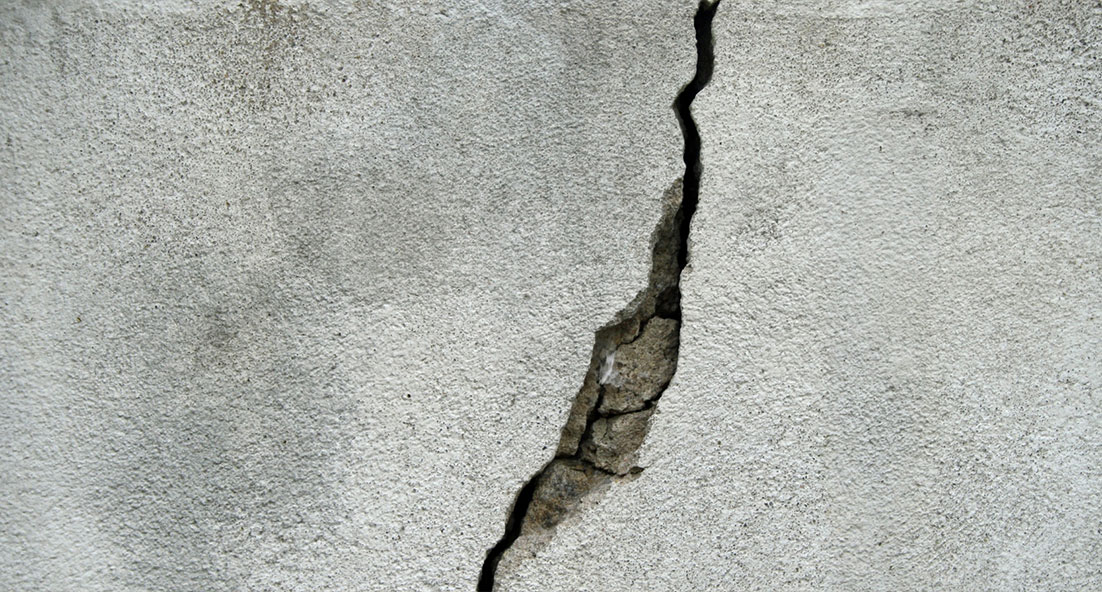
The repair of a damaged concrete floor doesn’t need to be a hard or tough repair job. It may surprise you how easily this can be done yourself.
Often caused by constant wear and tear, concrete floors end up becoming rough and difficult to clean. With concrete floor repairs, there are three types of repairs that are the most common; surface cracks, pitting and spalling of concrete – this requires more effort but is equally as repairable as surface cracks.
How to prevent and repair Surface Cracks
Concrete floors crack – pure and simple. It is not a material that stretches or bends without breaking. It does have the ability to shrink and expand with temperature, however, it cracks as a result. This is why it is important to have expansion joints built in to allow for this cracking. These encourage expansion to occur along the groves instead of across the surface of the concrete causing cracks.
If you are suffering from cracking concrete, an Internal Crackfiller is an extremely thin pure epoxy that is formulated to penetrate well down into the crack. Indeed, it is so strong that the resulting ‘repair’ will be stronger that the original concrete itself. With this, it is important to know that the sub-base must not be poor or unstable, or this could render any crack-filling exercise as time wasted.
When it comes to choosing the best and strongest product to repair your floors, it is important to choose a cementitious resin solution that is specially made for levelling rough or damaged concrete and is also able to withstand heavy levels of traffic. A suitable resin is able to easily fill unwanted dips and grooves. We also recommend the use of Epoxy, Polyurethane crack repair/filling compound as this cures to a strength that is greater than concrete. It also accepts floor coatings and floor paint.
Non-cementitious products can also be used, however, this is not as strong. Mixing the product with dried sand or a cement mix will provide an extremely tough topping that is well-proven across many industries.
Avoid: water-based or latex-based concrete crack fillers and/or repair products as they are not sandable, will not accept paint, and will shrink over time pulling away from the repair.
Recommended Crack Repair Products
For cracks that are 0.1mm – 10mm, we recommend using the Internal Crackfiller. This is a pourable ultra-low viscosity twin-pack epoxy that is designed to penetrate well into the crack and cures far harder than the original concrete.
Repairing Expansion Joints in Floors
In order to best repair an expansion joint, use joint sealant material that will easily withstand the wear and tear of the typical machinery and tractors used in grain stores. Simply ensure that the surface is clean and dry and pour the resin into the joint, leaving the surface nice and flush. For the best and neatest finish, mask either side of the joint and pour the resin just slightly proud of the top. Peel up the masking tape and just as it has started to cure, run a knife blade along the surface cutting off any excess material. This leaves the joint completely filled and with a super smooth finish with the surface, ensuring fewer snags with digger buckets etc. It is important that you do not leave it too long before cutting off the excess as after the resin has fully cured, this will be a lot harder to achieve.
Stop water penetrating under doors
Using an epoxy mortar will help water penetrating under doors. This can be mixed in quantities as little or as much as you need. It is resin rich so that you don’t even have to prime the surface. Mix up the quantity required (you can even do this with a gloved hand) and roll it into a form of a log, placing it along the door line. This can then be smoothed over and feathered down to nothing on either side in order to form a very small ‘speed bump’. Extremely easy and effective!
Another solution is using a very strong cementitious product whereby you simply mix the powder with the polymer. This can then be troweled into. A benefit of this as a solution is that it can be applied to a damp (but not soaking wet) surface.
Repairing General Concrete Floor Holes
Any of the above-mentioned solutions can be used for general holes and each has their own qualities. However, it is recommended not to use products that are fast curing on deep and large areas, as the heat caused will simply crack the repairs.
Damp Areas
Dampness can be experienced anywhere over the area but is mostly found emanating from expansion joints and cracks, or around the perimeter of the building where the dampness is either tracking through the concrete from the outside or is coming through the external walls.
If the damp is coming up through the concrete, a primer can offer a fantastic long-lasting cure for this. Whilst primers are indeed used for priming and sealing a floor prior to the application of a coloured top coat, a primer can, in fact, also be used as a sealer coat and will take an extremely lot of wear and tear by itself. If damp is penetrating through, we normally find it is only around maybe the first 3-400mm, and in such circumstances, we advise coating say a metre-wide strip around the perimeter.
If the dampness is coming up through joints or cracks, it is important that the void is completely dry before filling. If heat is needed, then a blow torch or hot air gun (even a hair dryer) can be used to dry the surface.

[…] you’ve inherited a premises with a concrete floor that’s been damaged, make sure you repair any issues before adding your coating. This might involve filling cracks, or applying a primer to prevent damp […]